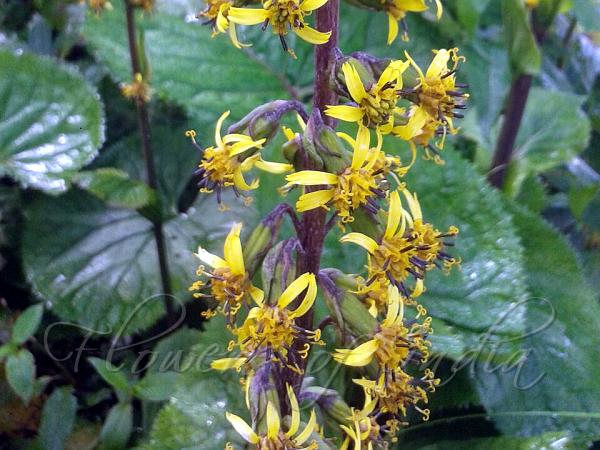|
| East-Asian Ligularia |
|

|

|
|
|
|
Photo: |
Botanical name: Ligularia fischeri Family: Asteraceae (Sunflower family)
Synonyms: Cineraria fischeri, Cineraria speciosa
Synonyms: Cineraria fischeri, Cineraria speciosa
East-Asian Ligularia is a stout erect and variable
perennial herb, with large heart-shaped to kidney-shaped, coarsely
toothed leaves up to a foot across. Lower leaves are long-stalked,
upper ones with winged sheathing stalks. Flowers are borne in a
spike-like cluster at the top of the stem, 27-75 cm long. Proximal
leaflike bracts ovate or ovate-lanceshaped, up to 6 x 2 cm, smaller
distally, herbaceous, margin toothed, tip mucronate; distal leaflike
bracts lanceshaped; flower-cluster-stalks: proximal ones up to 9 cm,
smaller distally, slender. Flower-heads are numerous; supplementary
bracts narrowly lanceshaped to linear. Involucre bell-shaped, 7-20 x
5-14 mm, outside shortly brown pilose; phyllaries 8-14, in 2 rows,
oblong, 3-5 mm wide, tip pointed; inner phyllaries broadly membranous
at margin. Ray florets are 5-9, yellow; blade oblong, 1.5-2.5 cm x up
to 6 mm wide, tip blunt; tube 5-11 mm. Tubular florets are numerous,
8-17 mm; tube 5-9 mm. Achenes dark brown, spindle-shaped-cylindric, 6-8
mm. Pappus yellowish brown, shorter than tubular flower. East-Asian
Ligularia is found in the Himalayas, from Pakistan to Bhutan, China and
Japan, at altitudes of 2100-3600 m. Flowering: July-August.
| Identification credit: Nongthombam Ullysess | Photographed in Arunachal Pradesh. |
• Is this flower misidentified? If yes,